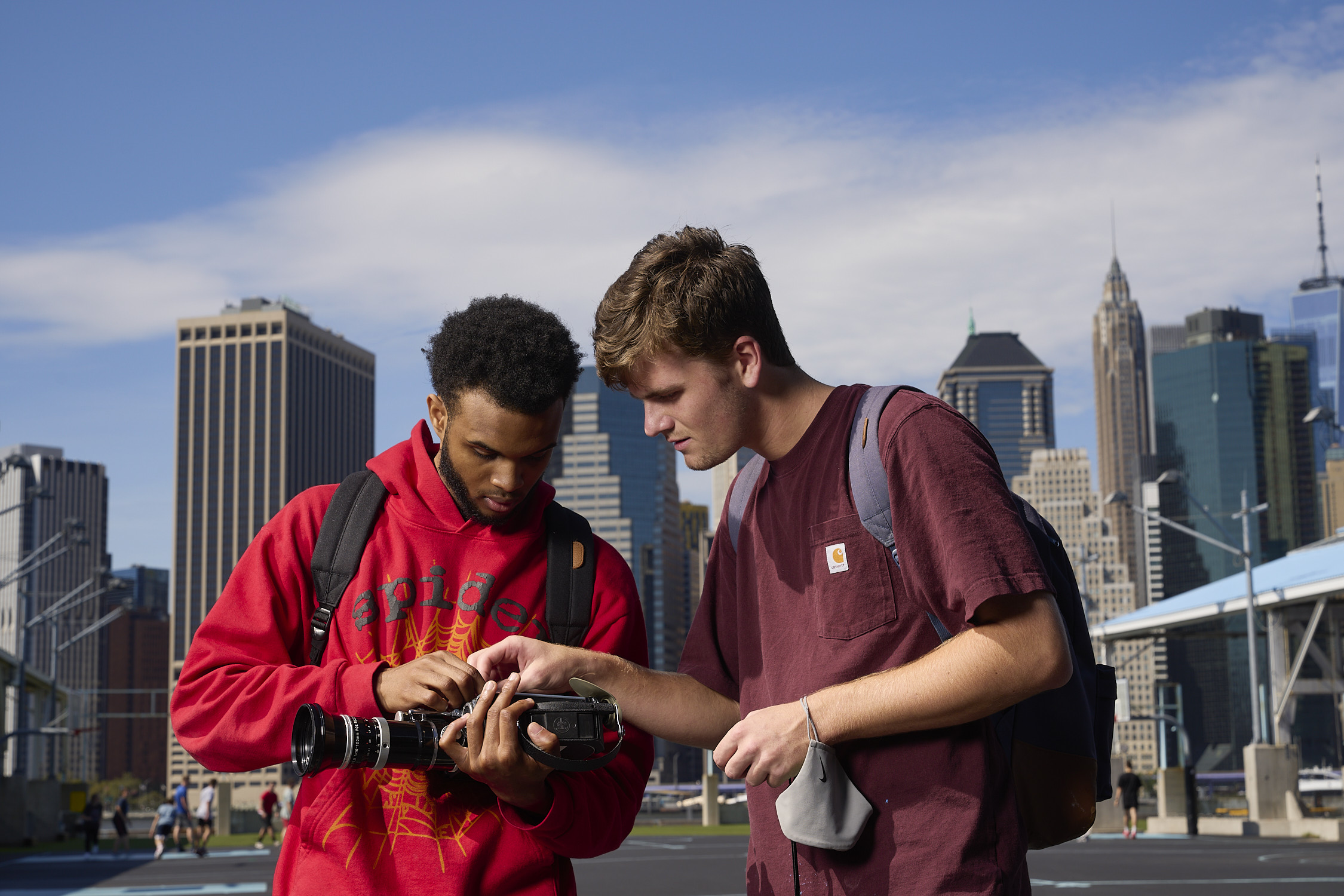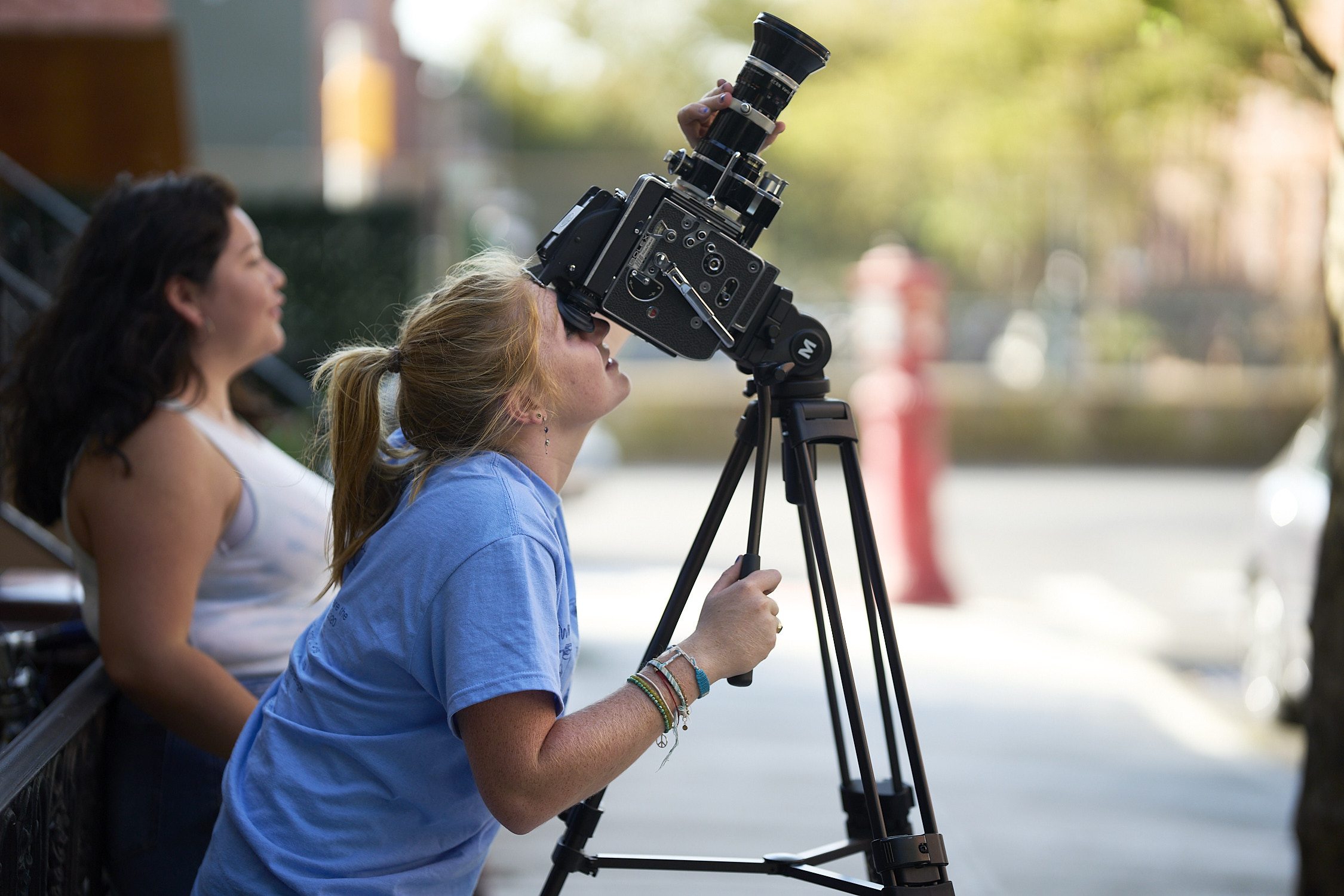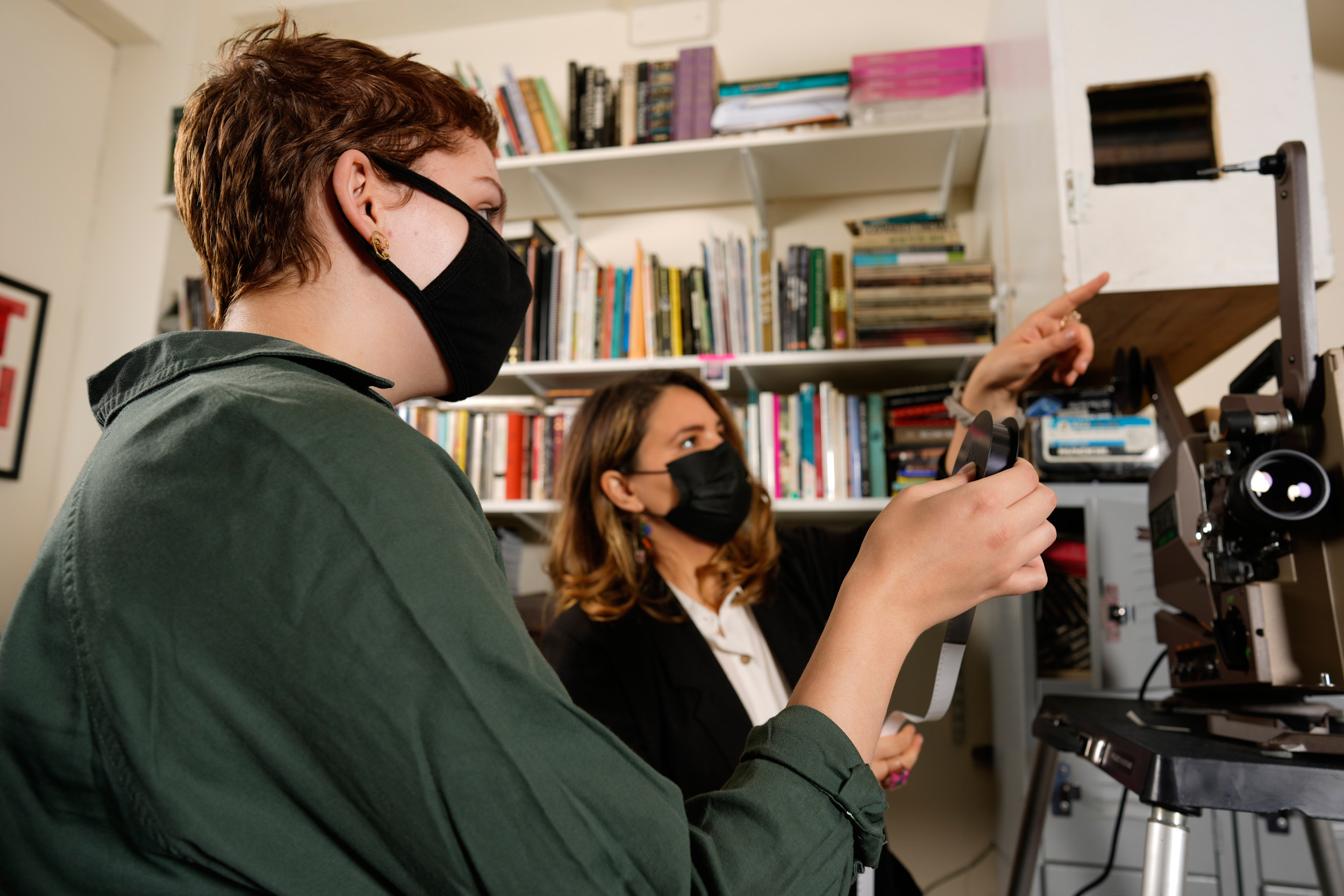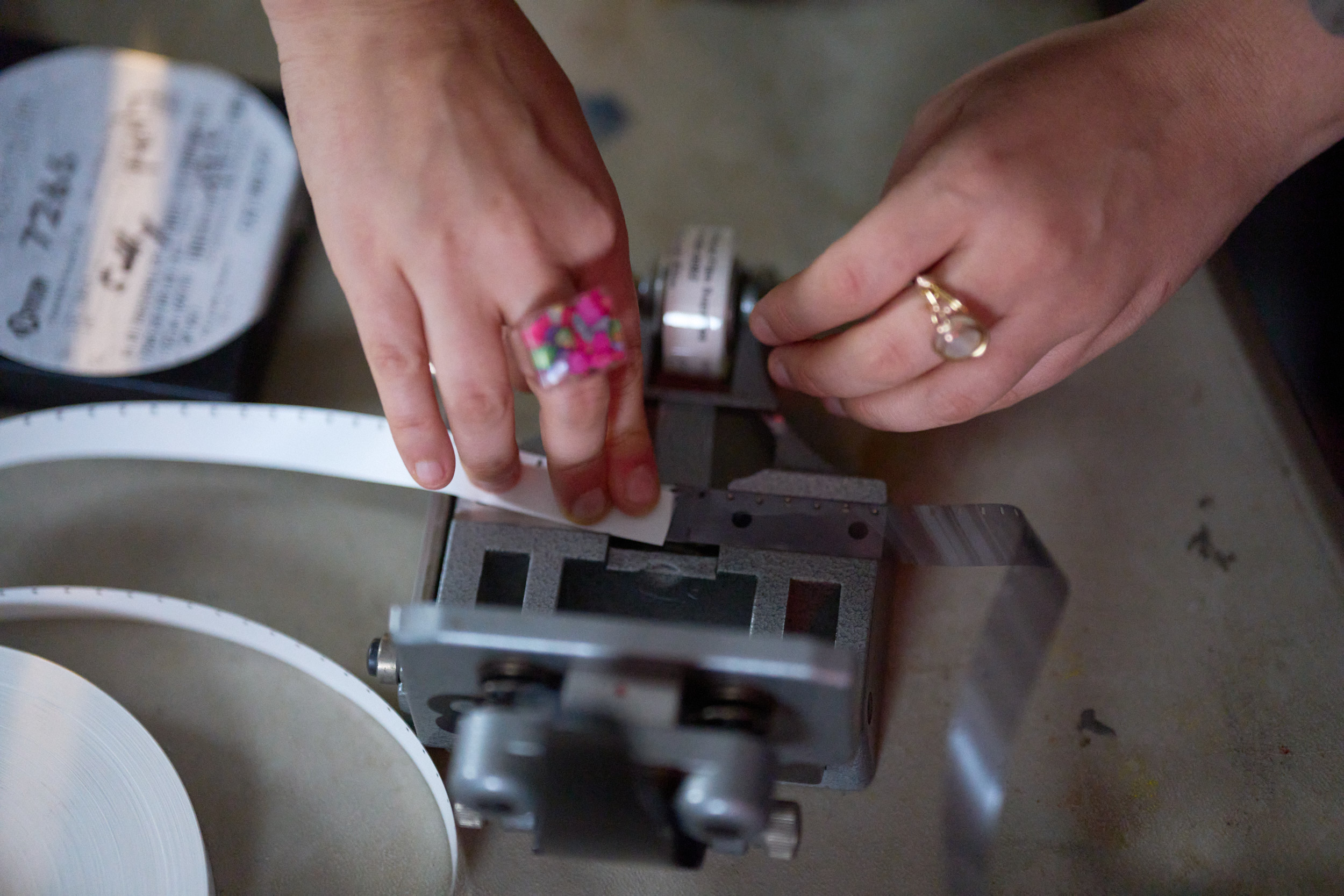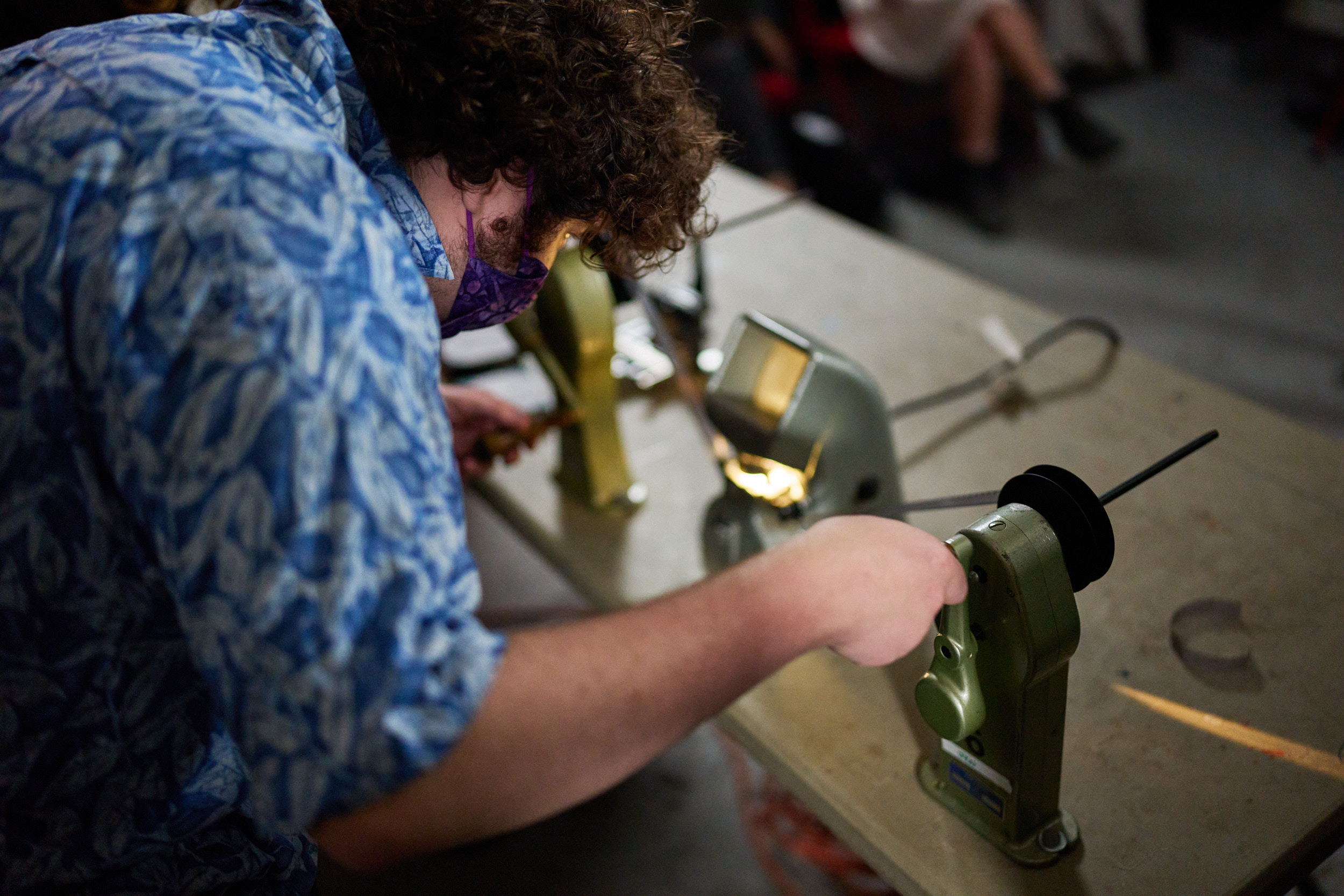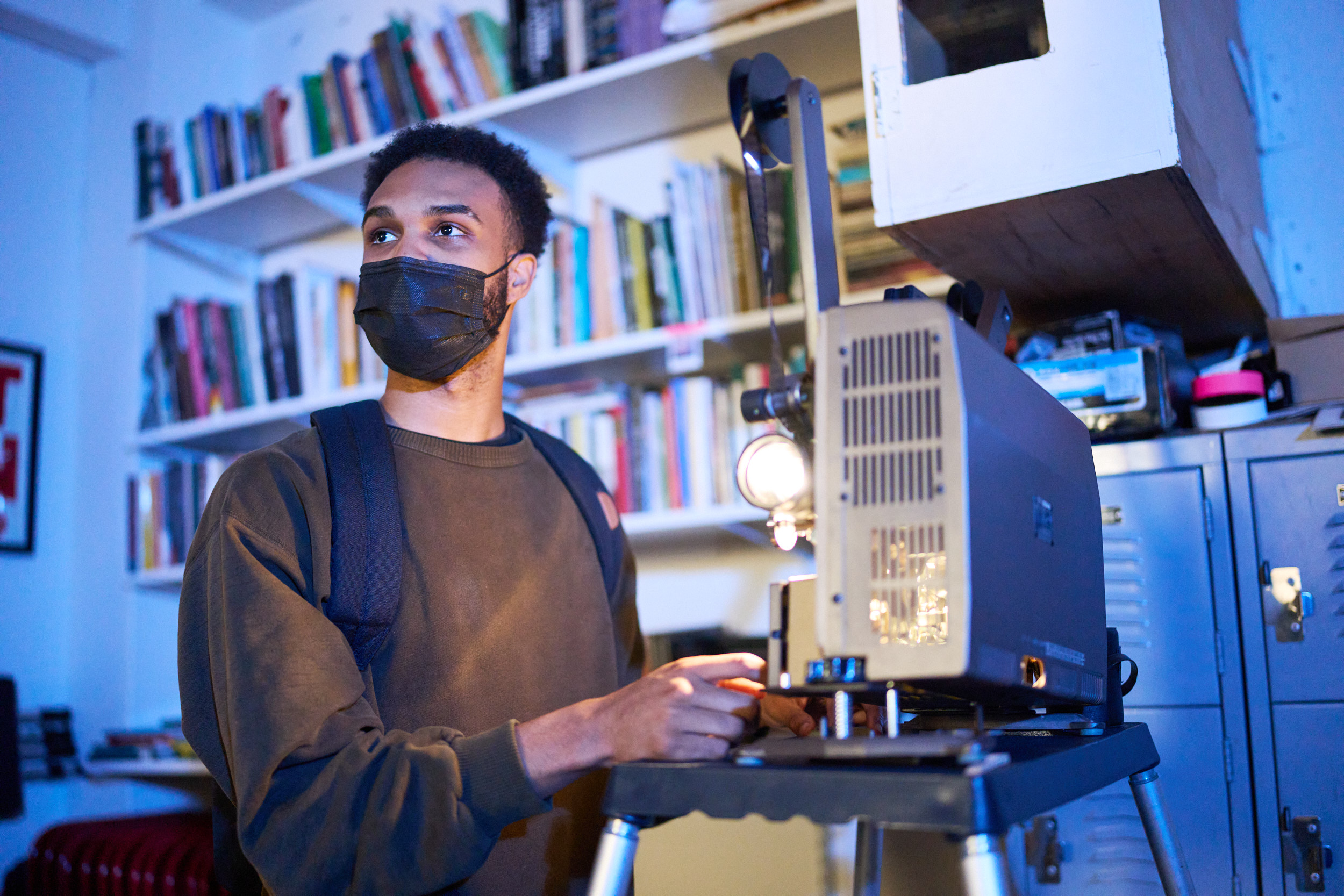Film and media studies students immerse themselves in New York City and learn from industry insiders.
The city awaits.
A group of 15 students heads to the New York Film Festival with passes in hand. There’s a red carpet. They watch Dune two weeks before it’s released in theaters. They see the U.S. premiere of Wes Anderson’s The French Dispatch and then catch a Q&A with cast members including Bill Murray.
This is just the start of the fall Film and Media Studies Off-Campus Study Group in New York City. The students have the whole semester ahead of them.
Another week, they’ll attend NewFest, an LGBTQ+ film festival, and a few will volunteer to assist with festival operations.
And on yet another occasion, they’ll venture to the opening night of DOC NYC to watch a screening of Listening to Kenny G., a documentary by former Colgate professor Penny Lane. One student, Rebecca Sweigart ’23, even dares to get a selfie with the Grammy Award–winning saxophonist. (“He is very kind,” she notes.)
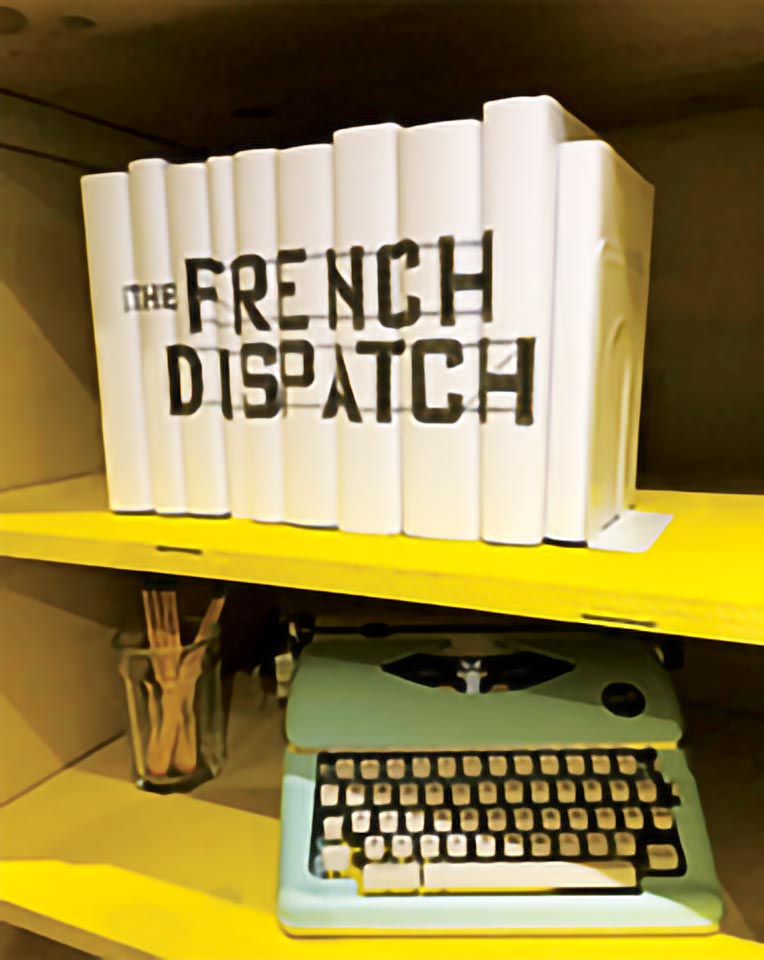
Back at headquarters — the Gotham Film and Media Institute in Brooklyn — students will meet with alumni such as Caitlin Grossjung ’13, a producer who has worked for National Geographic, Netflix, and Hulu.
In the classroom there, the students will dive into deep discussions during courses, including Hollywood and the World and New York Media, with their study group leader, Professor Mary Simonson.
“I want them to understand the ecosystem in which film and media are produced, distributed, and consumed, and how tightly connected those processes are to each other,” says Simonson, who is also the Daniel C. Benton ’80 Endowed Chair in arts, creativity, and innovation.
Throughout the fall 2021 semester, New York City served as a campus for students in film and media studies. In addition to attending film festivals and hobnobbing with industry insiders, they further developed their skills and knowledge base — all through Gotham EDU.
For one of their first assignments, called “city symphonies,” the students turned their lenses on the Big Apple, using Bolex cameras to make 16 mm films. Cait Carvalho, Gotham’s director of curriculum, taught the Independent Filmmaking Production course.
Decorian Sims ’22 focused on hoop culture, filming at Brooklyn Bridge Park. “It has a great backdrop of the city,” he says of the location. A longtime basketball fan from Atlanta, Sims had been looking forward to spending time in New York where outdoor courts are a place of camaraderie for both amateur players and NBA professionals.
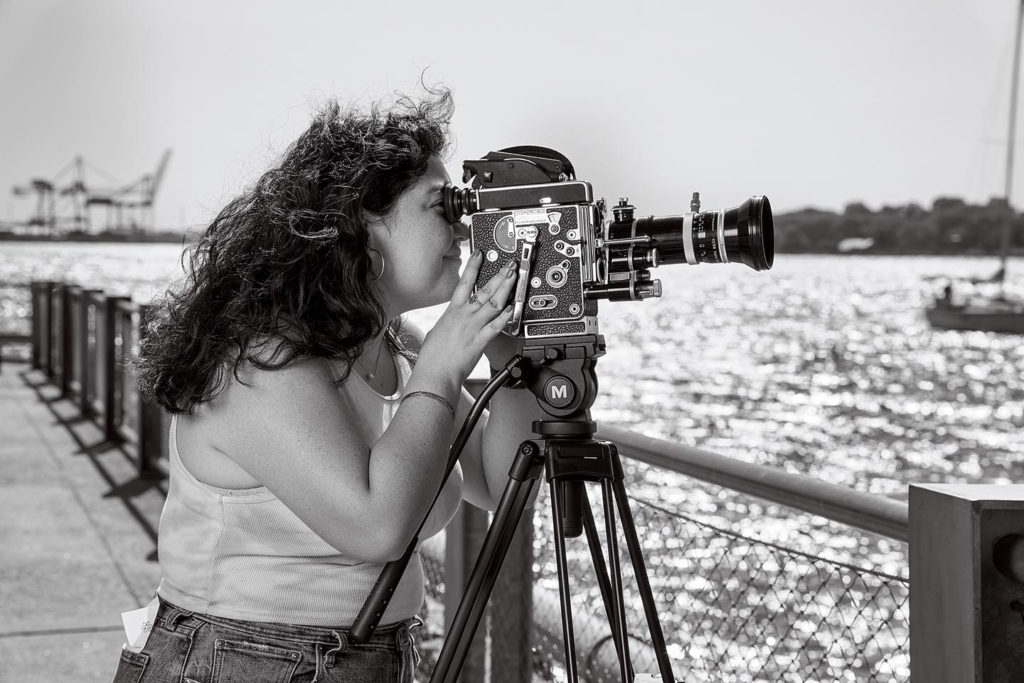
Jen Trujillo ’22 found inspiration for her film from an assigned reading in Simonson’s course Hollywood and the World: Performing Gender and Sexuality Onscreen. In the assigned book chapter, the author looks at public statues in New York City and notes the imbalance of those representing women versus men (5 vs. 150, which the city has been working to ameliorate in recent years). Trujillo says she wanted her city symphony to “portray women going about their days and how this city doesn’t have a lot of monuments or buildings [representing] them. What does that implicate for them in the city they inhabit?”
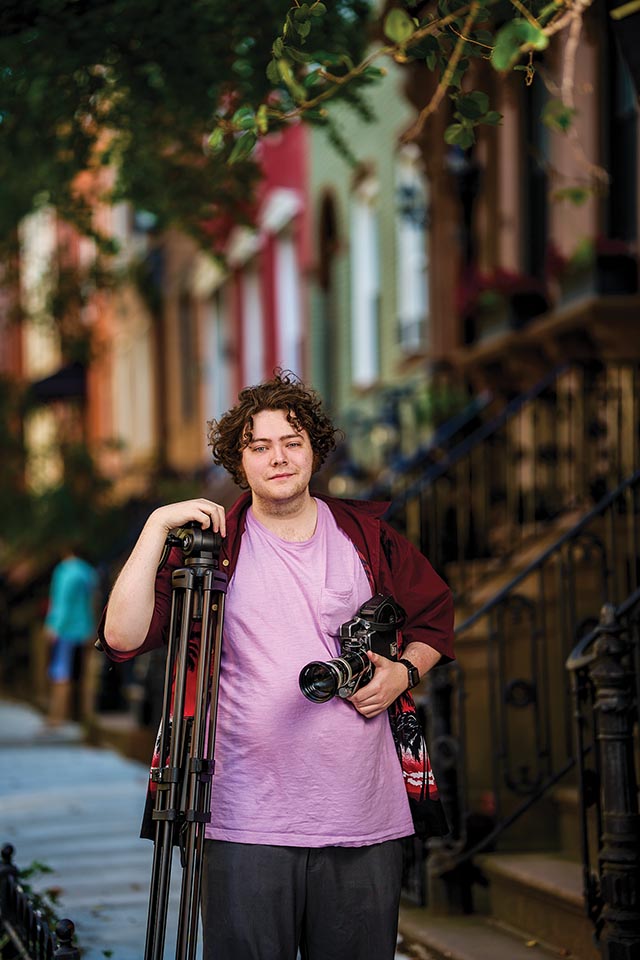
When Joe Giordano ’22 arrived in the city for the first time, they noticed the water and decided to use that as the theme of their film. “We’re right near the river, and it was something I never really thought about with New York City because I’d never been here before. You think about the cityscape and those crowded streets, but you don’t think about the water and the different things it can bring — the quiet and calm, which offset that intensity of the city.”
None of the students had ever worked in 16 mm before, so the hands-on learning brought new challenges and training. “I think it is really instructive and useful for them,” Simonson says. “This is a generation where many of them have never seen film; many of them have never even shot photos on film.”
When they finished several days of filming, the students gathered in an editing studio, cutting and splicing their footage by hand. “It’s so different from editing digitally — everything’s much more permanent,” Giordano says. “In digital editing, you can watch it immediately to see if you like it and then change it effortlessly. [With analog,] if you don’t like something and you’ve already taped it together, well, that’s a shame.”
After 9 to 5
Being in a place with so many possibilities, the students embarked on their own adventures in their free time.
Trujillo moved to the other side of the camera: Through a talent agency, she was cast as an extra on a new Apple TV+ show. The name of the show is a secret, but she can reveal that it’s a futuristic tale about global warming. “Being on the set and seeing all the moving parts coming together has really shown me the magnitude and the scale of what it takes to create films,” she says.
Meanwhile, after class, Sims rushed off to meetings at Turner Sports, where he is an NBA content marketing intern. For his final film class project, he compiled a montage of the greatest basketball players — a piece he hopes to use for a future campaign at Turner. “I’m making something that I feel will align with what I would like to do post-grad,” he says.
Giordano’s internship was at The Gotham, working in the archives. Giordano spent hours digitizing cassette tapes of filmmakers talking about their experiences. The clips are from an event the organization holds that’s now called Gotham Week. “These panels are important,” says Giordano, citing one example of a discussion about being a woman of color working in film and facing racism and sexism. This archival work is necessary “so we understand the mistakes of the past,” Giordano says. Like Sims, Giordano views the internship as valuable for the future. “I want to go into archival [work] as a career because I think it’s important that art and information are not lost, and it’s amazing how fragile some of the more significant media in the world can be.”
You Can Count on Him
Jeffrey Sharp ’89, executive director of The Gotham, had the vision for the institute’s EDU program when he accepted the position three years ago to run the organization that was then called the Independent Filmmaker Project. Sharp is a producer known for films including Boys Don’t Cry (1999), You Can Count on Me (2000), and Proof (2005).
At The Gotham, Sharp’s role is overseeing the creative programmatic side of the 40-year-old institute — which he has known since he embarked on his own filmmaking career. As an independent filmmaker starting out in the mid-’90s, Sharp relied on the organization: “It was the community you needed to connect with in order to figure out how to get a film made.” Today, filmmakers still come to The Gotham from around the world to “connect with pathways to real access,” he explains.
Through the EDU program, he wants to extend that pathway to students. “This initiative was something I wanted to develop as an opportunity for college students to come to New York… [I wanted to] create this footprint for them to explore the city and get a toehold on careers in the independent film industry,” he says. “As a New York filmmaker, I was watching [East Coast colleges] send our best and brightest students to the West Coast to pick up jobs, and I was thinking, ‘Why aren’t we supporting the filmmaking community in New York?’”
The timing overlapped with Sharp joining Colgate’s Board of Trustees, so he started working with Chief of Staff to the President Hanna Rodriguez-Farrar — whom Sharp says has “incredible relationships throughout academia” — to compile a list of institutions that might be interested in the program.
Gotham EDU launched in summer 2019, and Colgate was one of the first institutions to join, supporting the tuition for its students during that eight-week session. Building off the program’s summer success, Sharp worked with Simonson to expand it to this year’s semester-long experience. “This happened to be at the right moment for Colgate,” he notes, because the University is actively working to create more opportunities for arts students as part of the Middle Campus initiative.
Sharp interacted with students regularly in the fall, and he enlisted their help to pull off the institute’s biggest event of the year: The Gotham Awards show, honoring independent filmmakers. “They’ll be working behind the scenes to make it all happen,” he said at press time, anticipating the November event. “It’s a big night.”
Colgate students are the first to spend a semester at Gotham EDU, but Sharp hopes it will become a year-round educational program for multiple institutions. “Art is so collaborative,” he says. “Whether it’s the summer program or a semester program, you go back to [college] with a totally different perspective.”
Seven Things We Like About Jeffrey Sharp ’89
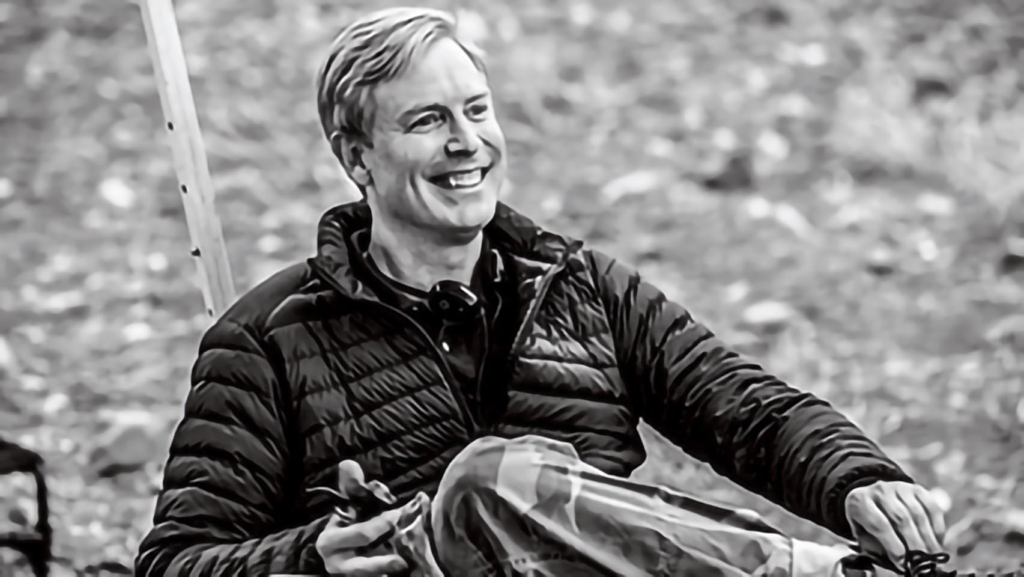
1
He’s producing a new movie starring Awkwafina. The Baccarat Machine (in pre-production) is based on a true story about a Chinese woman with a gift for gambling. “It’s a globetrotting, super fun movie about people defying the odds,” Sharp says.
2
His mentor at Colgate was John Knecht, the Russell Colgate Distinguished University Professor of art & art history and film & media studies emeritus. Sharp was a sociology and anthropology major; there was no film and media studies major at the time. “I petitioned to join one of John’s film classes, and this was the moment I realized I found my great passion in life.”
3
After graduating from Colgate, he moved to LA and worked with Oliver Stone on three films, including The Doors.
4
He earned his MFA at Columbia. There, he met director Kimberly Peirce, who was working on an early screenplay for Boys Don’t Cry based on the true story of Brandon Teena, a trans teen who was murdered as part of a hate crime.
5
With former HarperCollins CEO Jane Friedman, he co-founded the digital publishing company Open Road Integrated Media. “I was always fascinated with how, if you’re a creative producer, a book to build a film on is valuable real estate.”
6
Gotham EDU was partly inspired by his personal experience. Sharp took a year off from Colgate after his sophomore year so he could spend time in New York City: “I felt like I was missing out on the world.” Through this new program, students can enjoy “everything New York has to offer as part of their education, and they get credit for it, so that’s pretty amazing.”
7
His favorite movie: The Worst Person
in the World (2021), which he describes as a “Norwegian, dark, romantic comedy-drama film that I saw in Cannes this year.”
A Snapshot of Colgate’s Off-Campus Study Programs
Q&A with Joanna Holvey Bowles, director of off-campus study, and Martin Wong, associate dean of the faculty of global and local initiatives
What does the Office of Off-Campus Study do?
JHB: We offer programs in the United States and internationally, [including] opportunities in 50 countries, [through both our own study groups and] 107 off-campus approved programs (not operated by Colgate). We are the number one baccalaureate institution in the United States sending students for semester opportunities abroad because we have an unusually large number of semester-long faculty-led programs: 17–20 every year. In addition, we have extended study programs, which are on-campus courses followed by a field experience of three weeks.
MW: There’s no other small liberal arts institution that runs the number of programs we do. They are designed by our departments, our faculty. They can be tailored to fit in with our curriculum and with the Colgate ethos in general. That’s a really special and unique thing.
What is the history of off-campus study?
JHB: There’s a fascinating tale to tell. It was a post–World War II effort to encourage people-to-people friendships, academic-to-academic linkages that talked about peace time and not about warfare. Colgate is one of three institutions in the mid-1950s that was given money by the Department of State, which was a newly formed part of government, to try this out. The first place Colgate took students to was Mendoza, Argentina, to further their Spanish language skills and their ideas of politics and economics.
The first Colgate program to go international that is still operating is the London Economics Study Group that went in 1962 for the first time. [Our] oldest program in the United States is in Washington, D.C., as a sort of laboratory for learning about our nation’s capital. It was the first of its kind in the nation that began in 1935.
Before the pandemic, what was the typical number of students going abroad every semester?
MW: We typically have, on average, 450 students a year combined on both approved programs and Colgate’s own study groups. That means more than half of every class is participating, typically in their junior year, on the study-abroad programs. That demonstrates the hunger for students to be able to participate in these kinds of opportunities.
What off-campus study programs took place in fall 2021?
JHB: We had six study groups off campus, one in New York City and five in Europe. We had 100 students abroad.
MW: The reports we’re getting back are that, despite all of the challenges [due to the pandemic], faculty and students are having great experiences together. Students and faculty are finding ways to make it work, to retain that special experience.
What is the future of off-campus study at Colgate?
JHB: Adapting to new realities and student interests. What’s exciting is the advent of people being interested in new destinations, in creating opportunities that have not been open to students previously. Students are coming forward and saying, ‘Do you have a way for me to do this or learn this language?’
MW: Making sure we are flexible and dynamic in our programming and in a way that responds to changes in the field, in academic interests, and in programming at Colgate. As we roll out new academic initiatives like the Mind, Brain, and Behavior Initiative or Middle Campus, those things are going to be opportunities for us to change our programs.
— Excerpted from an interview by Dan DeVries on 13, Colgate’s podcast

